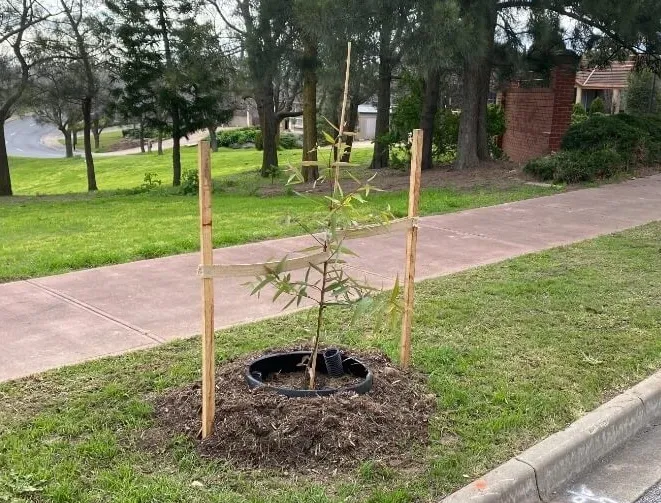
Did you know planting a tree at the wrong depth can cause issues for the tree? This article will explain the correct depth you need to plant trees. I’ll also offer some solutions to fix incorrectly planted trees.

When digging a hole for a tree, the depth of the hole should be no deeper than the root ball. Also, ensure the root flare is not buried when filling the hole with dirt. As a guide, roots need to be underground, and trunks need to be above ground.
I manage the tree planting program for my city. We plant thousands of trees every year and then maintain them for three years. I’ve seen firsthand what happens when trees do not get planted right.
Tree roots are designed to be underground. And, tree trunks are designed to be above ground.

The Correct Depth to Plant a Tree
A hole’s depth should be no greater than the root ball’s height. The size of a root ball will vary from tree to tree, and so too will the holes.
When digging a hole for a tree, keep placing the tree in the hole to test its height. When the top of the root ball lines up with the top of the hole, you can start filling the hole with dirt.
The rootball is an excellent indicator of hole depth, but it isn’t perfect. You still need to ensure you don’t bury the root flare too.
The root flare (also called trunk flare) is the part of a tree where the first root attaches to the trunk. You will find the root flare at the bottom of the tree, where the stem turns into roots. As the stem turns into roots, the stem will gradually get wider. See the diagram below for a guide.

Or if you prefer videos, the following video will show you how to find a root flare.
I fill the hole full of dirt, sometimes covering the root flare. I then begin lightly compacting the soil and removing any excess soil. I continue this method until the hole is full, but the root flare isn’t buried.
Summary: Use the height of your tree’s root ball to determine the depth of the hole. Fill the hole up to the tree’s root flare. The root flare needs to be exposed.
What Can Happen if You Don’t Plant a Tree at the Right Depth
Planting a tree at the proper depth is essential. Otherwise, problems can start to occur. There are two ways people go wrong with hole depth:
- Planting the tree too shallow
- Planting the tree too deep
Here, I will cover each scenario and explain what can go wrong.
Planting the Tree Too Shallow
A tree planted too shallow will often have a portion of its roots above ground. Roots that are not buried rapidly dry out and die. When roots begin to die, a tree’s health rapidly deteriorates.
Tree roots deliver water and nutrients to the rest of the tree. So, it’s important to fix any root issues immediately.
For an extensive guide to tree roots, check out this article.
Add more dirt if you think your tree hasn’t been planted deep enough. Fill the hole to the level of the root flare. Give your tree deep water, then apply mulch around the tree’s base.
When mulching, don’t cover the stem of the tree.
Summary: Trees that aren’t planted deep enough often have exposed roots. Exposed roots dry out and die, killing the tree.
Planting the Tree Too Deep
It’s much more common to see a tree planted too deep. I see this problem quite a lot in my line of work.
Here’s a photo of a tree I recently came across:

Trees planted too deep often run into several problems. These problems include:
- Slow growth and development
- Vulnerability to decay
- Vulnerability to other pests and diseases
Too much dirt covering the stem will keep the stem moist. Too much moisture is a bad thing. Moist conditions are ideal for fungi and other pathogens.
Too much dirt will also deplete air levels in the soil. Tree roots need air to survive, which is why compacting soil can harm a tree. Poor air quality in soils can lead to development issues and even the death of a tree.
For a juvenile tree, you can remove excess dirt. You can remove the dirt with a small trowel. With larger trees, it gets a little more complicated.
Air spading is the best option to remove excess dirt from a mature tree. Air spading is when an arborist uses a high-pressure air gun to remove excess dirt around a tree. Air spading is an excellent option to protect tree roots.
Summary: Trees planted too deep are vulnerable to decay from pathogens, fungi and other pests and diseases.
If you need help in any other aspect of tree planting, check out this article. In this article, I cover step by step-how to plant a tree.
